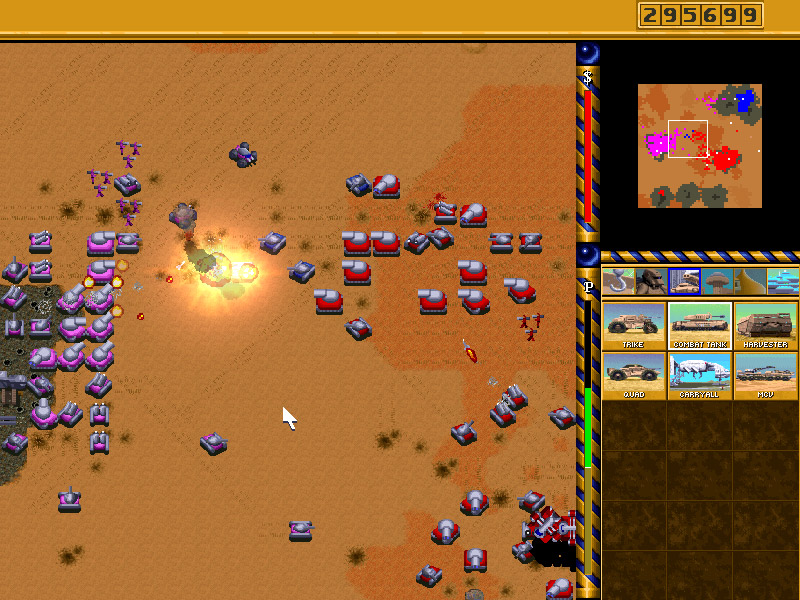Dune 2 superfan spends 20 years remaking cult classic PC game

Dune the book made a big splash in the literary world when it was released in 1965, but many would argue that Dune II the video game made an even big splash in the gaming world. Those of us who were already gaming in 1992 immediately realized just how special this game was, and how it will change gaming forever.
Dune II allowed players to control large armies to go up against equally large or larger opposing armies. But unlike the turn-based strategy games of the time, you could control and direct your troops in real-time. Rockets roared from turrets and tanks to pound the enemy, while speedy trikes and quads flanked infantry squads.
Herzog Zwei on the Megadrive might be considered the first Real-Time Strategy (RTS) game, but Westwood Studios’ Dune II was the first one to define it the way we know it today.
It introduced familiar concepts like:
Without Dune 2 we would not have beloved franchises like Command & Conquer, Warcraft, and StarCraft. And whether you’re an RTS fan or not, these great franchises have influenced all kinds of gaming genres in many positive ways.
Stefan Hendriks was one such gamer for whom Dune II had a profound effect. He was just 10 when the game was released and he was blown away by its unique gameplay. “At the time there was nothing like it,” said Hendriks. “Combined with the awesome music and graphics, and I was hooked.”
For a lot of gamers, the impact of such a memorable gaming experience would be that we’d continue to talk about the game with friends and on Internet forums for decades. For Stefan, it inspired a desire to write code and begin the journey of building such a game.
At the age of 13, he coded Dunedit, a tool to edit Dune II scenarios. At 15, he made a clone of Dune called Arrakis which updated the controls to the modern standards set by the newer Command & Conquer and Red Alert games.

Soon after, he started from scratch to begin what would become a 20-year open-source project called Dune II – The Maker.
If you look on the Google Play Store, you will find other Dune II games but these are direct ports of the original game, optimized for mobile. Dune II – The Maker is different because it is made from scratch with an original engine and modern improvements such as unit grouping, map zooming, and improved enemy AI.

“I don’t aim to recreate a Dune II AI,” he said. “Rather, I try to think how I would implement an RTS AI that would make a game like Dune II fun to play.”
Fans of the game will remember that after a while, the original AI would send units to attack the player’s base one at a time – which made them pretty easy to repel once you had enough rocket turrets. Hendrik’s improved AI gathers units into groups and then sends them in attack waves, which is more like Command & Conquer than Dune II.
The graphics are updated, though it still looks undeniably like Dune II. Hendriks said that the early iterations of Dune II – The Maker made use of graphics extracted from the original game, but they were too tiny in high-res. Hendriks received help from fellow fans in the Dune2k forums who polished the graphics for him.
The game is far from complete now, as it still lacks an options menu and the ability to save your progress. Cutscenes haven’t been integrated either. As he only works on it in the evenings after his day job (and mostly by himself), Hendriks estimates that he will need another few years to complete the game.
But the core gameplay is functioning, and players can already jump in and blow up some quads and ornithopters.
Hendriks has other changes in mind, such as new playable factions with unique structures and Dune lore-related elements, but those are still far off. What he would most want to add is multiplayer support, though that is a feature that he has no idea how to do.
“Regardless, I want to try someday.”
An ambitious project like this is quite an undertaking, but Hendriks has learned a lot from it. He is constantly trying to understand how things in the game work, and then figuring out how to build and improve them. On the project management side of things, he has also learned to keep changes small and to keep his momentum going.
All of these lessons have also helped him in his day job as a software engineer. As such, he recommends that readers should try such a project if they’re interested.
“If you ever want to build a game. Go for it. Do it. It is such a great learning experience. There are a lot of great resources and people out there. And it is very rewarding when you see people playing your game, commenting on it and such.”
If you’re interested in reliving the glories of Dune II or experiencing it for the first time, download Dune II – The Maker from its website. Version 0.6.0 has just been released, which includes a new AI, improved air unit behavior (for carry-alls and ornithopters), and the introduction of all three super-weapons for the 3 Houses! The Ordos Saboteur is now controllable and thus far more useful than its original incarnation (see above).
Or you can also follow Hendriks on Twitter (as @dune2themaker) to keep tabs on his regular updates.
This article was first published in Geek Culture.